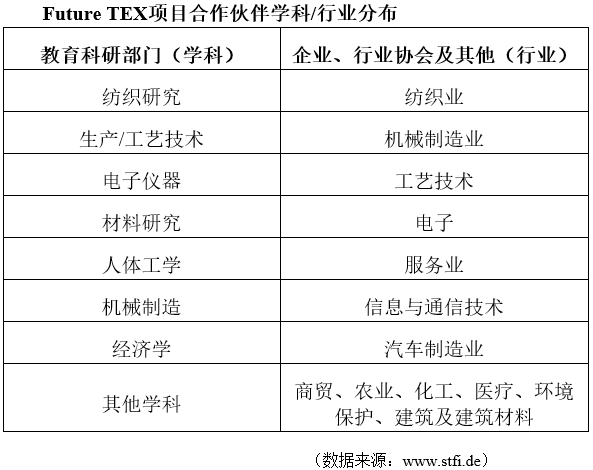The textile industry is Germany’s traditional advantageous industry. In the fierce global competition, the Germans clearly realize that the textile industry has now broken through the traditional cognitive categories and developed into a new industry based on new textile materials and intelligent products. In recent years, in order to maintain its market competitive advantage, Germany has elevated the transformation and upgrading of the textile industry to a national strategic level, repositioning the industry and transforming it for the future.
1. The “Future Textile” project to support the transformation and upgrading of the textile industry in eastern Germany
In 2014, Germany launched the “FutureTEX” project with the main purpose of promoting the transformation and upgrading of the eastern textile industry. The Saxony/Thuringia region in eastern Germany is a traditional textile industry base. This region has a good industrial tradition and a large number of related industrial facilities, as well as many scientific research institutes in the textile field. FutureTEX promotes industry-university-research cooperation in this core area and focuses on breakthroughs, thereby driving the upgrading of the national textile industry. Due to historical reasons, the economic development of the eastern region has always lagged behind that of the western region. The FutureTEX project focuses on Saxony/Thuringia, which also reflects the German government’s strategic consideration of “revitalizing the eastern region”.
As a model of the upgrading and transformation of traditional German industries, the FutureTEX project received financial support from the “2020 Innovation Partner” of the German Federal Ministry of Education and Research (BMBF). In the context of Industry 4.0, FutureTEX encourages universities, scientific research institutions, enterprises, industry associations and other units to actively participate in innovative project cooperation, with a view to integrating forces from all walks of life, forming strategic alliances, promoting a new generation of textile revolution, and providing cross-industry, multi-disciplinary cooperation sets new standards.
Establish the future model of traditional industry. In terms of project positioning, FutureTEX combines concepts and specific research directions, hoping to build future models for traditional industries under the wave of the fourth industrial revolution. The project has established three major goals: to improve resource utilization and promote a circular economy; to create a customer-centered flexible value chain; and to develop new textile materials for the future.
Lead the industry with innovation. The FutureTEX project was established to continue to consolidate and expand Germany’s global leadership in the field of technical textiles and textile machinery manufacturing in the next 10 years. To this end, FutureTEX has identified four basic project modules, namely: Smart Factory, Mass Customization, Open Innovation and New Enterprise Talent Environment (Arbeitswelt4.0). In addition, FutureTEX has also set up many specific innovative research projects, such as the RecyCarb project led by the Bremen Fiber Institute, which studies the recycling and high value-added reuse of carbon fiber material waste; the PhotoTex project mainly responsible for the Fraunhofer Institute of Electronic Nanotechnology, Focus on developing flexible fibers with photovoltaic properties.
Industry-university-research cooperation promotes industrial upgrading. Multidisciplinary cross-border cooperation is the main feature of the FutureTEX project. Currently, more than 180 units from 14 federal states have participated in the FutureTEX project, of which 66% are enterprises (mainly small and medium-sized enterprises) and research institutions. Accounting for 26%, the remaining 8% are industry associations or other institutions.

Nowadays, the research tentacles of the German textile industry have obviously been greatly extended, far beyond the scope of vision of general industry planners and industry trackers. For example, the “TexPCB” project led by Norafin Company bids farewell to traditional raw material ideas and uses natural fibers to make textile materials to achieve energy self-sufficiency; the “Urban Farming” of the Saxony Textile Research Center (STFI) is committed to researching applications in urban vertical greening and roofs. Green textiles help with building waste gas treatment and water treatment.
The open source cooperation platform improves the efficiency of achievement transformation. Through cross-border cooperation, the FutureTEX project provides an open source cooperation platform for scientific researchers and enterprises to create an efficient knowledge management and innovation system. From the perspective of knowledge management and innovation, the problems faced by the textile industry are: innovation activities lack efficiency and systematicness, and innovative ideas and research results from scientific research institutes cannot be quickly transferred to enterprises to form new products. To this end, the FutureTEX project starts from three aspects: “creative management”, “open innovation” and “knowledge transformation”, and strives to establish an efficient system to identify, develop and commercialize ideas.
Talent training ensures the sustainable development of the industry. FutureTEX’s project framework focuses on personnel management and training systems, especially the training mechanism for teenagers. The FutureTEX project noticed two key issues: first, the human-computer interaction model has new connotations in the Industry 4.0 era, and second, the impact of Germany’s continued population aging on the industry. For this reason, FutureTEX has specially established a project to solve the following problems for the German textile industry: How to deal with the trend of discrete and decentralized human resources organizations? How to unify topics such as people’s physical and mental health and improving productivity in human resource management? How can work organization methods and education and training systems better serve Industry 4.0 in the context of aging?
From the above analysis, it can be seen that through technological progress and product innovation, the German textile industry has achieved rationalization.�Layout. Judging from the current global market share, Germany has become a leader in the field of high-tech textiles, and the textile industry is developing towards sustainable and healthy development. “Future Textile” focusing on the new century
AAAGFHTRYKUYIU7OUP






